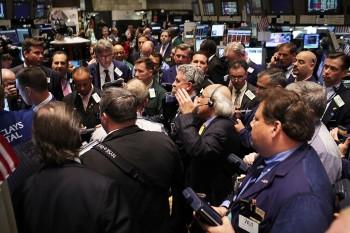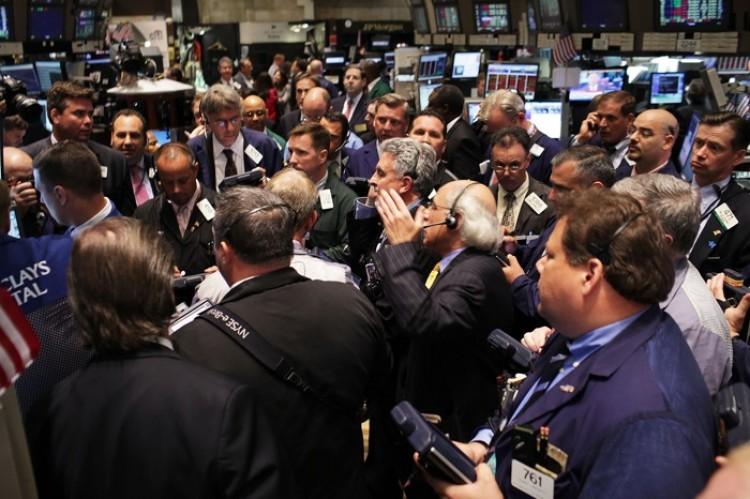Narrowing it down to stock ownership, some experts claim that it is driven, in a broad sense, by evolutionary forces that arise from changing demands in the business environment, while others say that concrete factors affect stock ownership.
Trends in the stock market point to taxation as a major force in the composition of stock ownership with interest rates ranking as second, argued Hugh James “Jim” Saxton, former member of the U.S. House of Representatives and former vice chairman of the Joint Economic Committee, in a 2000 Joint Economic Committee Study.
A Stanford Business Magazine Online article points to a realignment of stock ownership, which was predominantly in the hands of individuals before World War II. After the end of World War II, the composition of stock ownership changed drastically, with institutional stock ownership increasing significantly, while individual ownership took a nose dive.
“Since World War II, financial institutions have come to own a far greater proportion of stocks than private households have. Just after the war, individual citizens owned 90% of the stock market; by 2006, they owned only 30%,” according to the 2010 Stanford Business Magazine article.
The researchers discovered that in the 1980s, mutual funds (companies that invest money from many individuals in stocks, bonds, or other assets and hold them in a portfolio), pension funds, or insurance companies held less than 4 percent of all stocks in their portfolios, while today, they hold 70 percent of U.S. stock in their portfolios.
Just as Jim Saxton, the researchers in the Stanford article argued that stock ownership is driven by more mundane factors, that is, by a country’s tax policy, and not by popular public demand or evolutionary factors.
In another article on the VOX website, a think tank for economic policy research, the authors quote a 1986 publication that states that “tax policy changed the ownership structure of the US stock market.”
The researchers point to the country’s tax policy concerning retirement savings and that pensions greatly affect decisions as to how to invest disposable income.
Individual stock ownership is subjected to heavy taxes, such as a capital gains tax, when one sells the stock at a profit. Also, dividends earned through the years are subject to income tax.
On the other hand, pension plans are subject to a favorable tax code, a two-pronged vehicle: One pays no taxes while the money is invested in the fund and less taxes when one draws down the so-called savings, as one has a lower income in retirement.
When it comes to retirement funds, “employers and employees can contribute pre-tax dollars, which means that households can reduce their marginal tax rates by shifting taxable income from high-income work years to low-income retirement years,” according to the VOX article.
The researchers concluded that tax policies drive stock ownership, and the forces that have responsibility for tax policy should take note. In retrospect, should tax policy change and pension plans become subject to taxation, the composition of the stock market would change significantly.
Woes of Pension Plans
“Pension funding levels at large companies improved modestly at the end of last year, largely due to the moderate stock market gains and employer contributions,” according to an April press release issued by Towers Watson (TW), a consulting firm.
The TW Pension 100, an analysis of 100 publicly traded companies, found that the average pension fund increased by 3 percent by January 1, 2011. Firms provided $10 billion more in funds during 2010 when compared to 2009. In 2010, they added $30 billion, with the plans holding by year-end a combined wealth of $926 billion, close to a 10 percent increase.
But “while the aggregate funding status increased over the last year, funding status has still declined by $267 billion since the end of 2007, when the average pension plan was fully funded,” said the Towers Watson press release.
Lower interest rates also had a detrimental effect on pension funds as pension liabilities increased, while income decreased, and thus the pension plan lost a major revenue source.
Pension plan assets deteriorated by $641 billion in 2009, according to a U.S. Census Bureau press release in April regarding the state of pension plan assets.
“The nation’s state retirement systems totaled $2.0 trillion in holdings and assets in 2009, a loss of $641.3 billion (24.0 percent) from $2.7 trillion in 2008. … This follows a $152.2 billion loss the previous year,” according to the Census Bureau.
A $485 billion drop in 2009 investment earnings was the main factor for the decrease in pension assets. The pension funds did not do any better in 2008, when a $440 billion decline was noted.
With respect to corporate pension funds, many of the funds are frozen (30 percent) as no new participants are allowed in, and the funds no longer accumulate any benefits, although they still show a little life. A small percentage (3 percent), have ceased to exist or are on the way to being closed out. About 31 percent of these plans are still viable and accrue benefits, but allow no new employees into the plans. Only 36 percent of the funds are functioning and will accept new entrants.
“With such a high percentage of plans currently being closed or frozen, it is important that plan sponsors have a full understanding of how to de-risk the portfolio as funded status improves,” said the SEI Institutional Group, a manager of pension and other funds, in a recent press release.
Next...State and Local Government Pensions in Good Shape
State and Local Government Pensions in Good Shape
“Public pension trusts are designed to weather market volatility and have done so repeatedly—the past 25 years alone has included three economic recessions and four years of negative median public fund investment returns,” testified Keith Brainard, research director for the National Association of State Retirement Administrators, before a U.S. House of Representatives committee at the beginning of this year.
As of January, $2.7 trillion were held in state and local government pension plans.
Despite several economic downturns since 1985, the public pension plans have done exceedingly well. Between 1984 and 2009, these retirement plans earned a median of 9.25 percent on their investments. Over fiscal year 2010, which ended on June 30, 2010, the plans earned 12.8 percent on their investments, when compared to corporate pension plans, which earned 8 percent during the same period.
Besides the satisfactory state of the earnings, public employee pensions are a small part of state government spending. About 50 percent of the states spend only around 2.5 percent on pension payments for the approximately 7.5 million retirees.
Nevada, Rhode Island, and West Virginia spent the most for their retirees in 2008, amounting to 5.44 percent, 4.65 percent, and 3.01 percent respectively. The lowest percentage spent was by North Carolina (.92 percent).
“The assertion that public employee pensions are contributing in a meaningful way to state insolvency is simply not supported by the facts,” said Brainard in his testimony.
Historical Overview of Stock Ownership
“Before the Civil War, most nonfinancial business investment was financed internally with retained earnings. … The chief exceptions were the canals and railroads, which were actively issuing stocks and bonds in the 1850s,” said Roger W. Ferguson, Jr., vice chairman at the Federal Reserve Board, in a presentation to the American Economic Association in 2004.
After the Civil War, the U.S. business sector realized that expansion could only be accomplished through external financing, and borrowing from banks became a major source for expansion.
After World War I, equity markets became of major interest, and stock sales increased from 186 million shares to over 1 billion shares by 1929. In the early 1900s, individual and not corporate investors held 500,000 shares, which jumped to 10 million shares by 1930.
“The 1950s and 1960s were characterized by a sharp rise in the importance of large institutional investors—especially pension funds—in the stock and bond markets,” said Ferguson in his speech.
By 1995, financial institutions held 45 percent stock in corporations, nonfinancial firms held 24 percent, and individuals held the remaining 31 percent, according to a stock ownership timeline on the Internet.







Friends Read Free